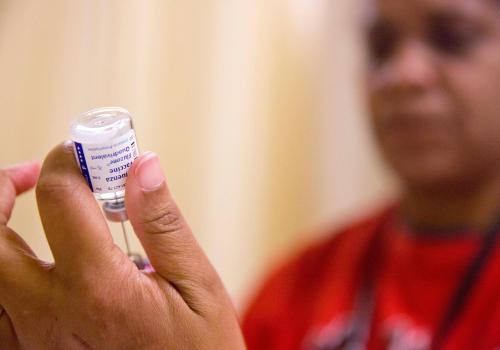A long-standing controversy surrounding flu shots is being revived by the Trump administration’s vaccine advisers: should the final few vaccines that contain the contentious additive thimerosal be discontinued?
Related Articles
-
We are still here, yet invisible : Study finds that US government has overestimated Native American life expectancy
-
States can cut off Medicaid funding to Planned Parenthood, the Supreme Court rules
-
Kennedy says US is pulling funding from global vaccine group Gavi
-
FDA requires updated warning about rare heart risk with COVID shots
-
Kennedy s new vaccine panel alarms pediatricians with inquiries into long-settled questions
Since research revealed no proof that the preservative causes any health issues, the question appears to have been resolved years ago.
According to Dr. Sean O. Leary of the American Academy of Pediatrics, this is actually not a problem.
Here are some facts on the material.
Since the 1930s, several vaccines and other medical items have contained the preservative thimerosal.
Since the vessel was punctured repeatedly to remove a dose, it was primarily employed in vaccination vials with multiple doses to prevent bacterial contamination.
Because thimerosal contains a type of mercury, concerns were raised concerning it in the late 1990s.
It is not the same as methylmercury, the hazardous form that can be found in some shellfish. According to O Leary, the body can eliminate a different kind of mercury called ethylmercury instead.
There was little ethylmercury in each dosage of the vaccination, and research revealed no negative effects. Furthermore, not all immunizations contained it. For instance, the Centers for Disease Control and Prevention claim that it was never present in vaccines for polio, chickenpox, measles, mumps, and rubella.
However, the United States removed the preservative from pediatric immunizations as a precaution. Since 2001, all vaccines that are regularly advised for children in the United States who are six years of age or younger come in formulations free of thimerosal.
A limited number of flu shot formulas in multi-dose vials that can be administered to both adults and children are an exception. However, according to O Leary, the great majority of kids receive their flu shot as a single dose.
The CDC reports that 96% of all flu shots given in the United States during the previous fall and winter, as well as a larger percentage of those used in government supported programs, were free of thimerosal.
Longtime anti-vaccine campaigner Robert F. Kennedy Jr., the U.S. Health Secretary, has long argued that there is a link between thimerosal and autism.
Lyn Redwood, a nurse practitioner who previously oversaw the antivaccine organization Kennedy established, was scheduled to give a presentation to his recently appointed vaccination advisers on Thursday.
According to meeting documents published earlier this week, she will recommend that the remaining flu vaccines that contain thimerosal be discontinued. One of the allegations was that they might endanger expectant mothers.
There was no connection between the preservative and autism or any other neurodevelopmental problems, according to a fresh CDC staff report that was produced for the meeting.
Following the removal of thimerosal from vaccines for young infants in the United States, some experts have observed an increase in autism rates.
The Robert Wood Johnson Foundation and the Department of Science Education of the Howard Hughes Medical Institute provide support to the Associated Press Health and Science Department. All content is entirely the AP’s responsibility.











